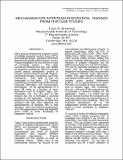Mechanisms for Interteam Integration: Findings from Five Case Studies
Author(s)
Browning, Tyson R.
DownloadCP_brow97.pdf (38.68Kb)
Terms of use
Metadata
Show full item recordAbstract
Many product development programs consist
of multiple integrated product teams (IPTs)
and functional groups. Interteam information
dependencies greatly affect program success.
Program integration has thus become an issue
of increasing interest. This paper
summarizes findings from five case studies
of integrative mechanisms (IMs) in complex
system product development projects at
Chrysler, General Electric Aircraft Engines,
McDonnell Douglas, Sundstrand, and Texas
Instruments. Two types of IMs are
investigated in this paper: (1) Systems
engineering and interface optimization and (2)
Improved information and communication
technologies. As the appropriateness of a
given IM varies as a function of many
parameters—such as program stage, size,
complexity, risk, etc.—the goal of this
research was not to formulate a universal
template for IM application. Rather, it is
hoped that the lessons learned by these five
programs will help others determine the
appropriateness of particular IMs in their
situations. Also, the continued development
of an IM categorization scheme will hopefully
prove useful to those developing an
integration “tool kit.”
Date issued
1997-08-03Keywords
product development (PD), integrated product teams (IPTs), interteam, integrative mechanisms (IMs)
Collections
The following license files are associated with this item: